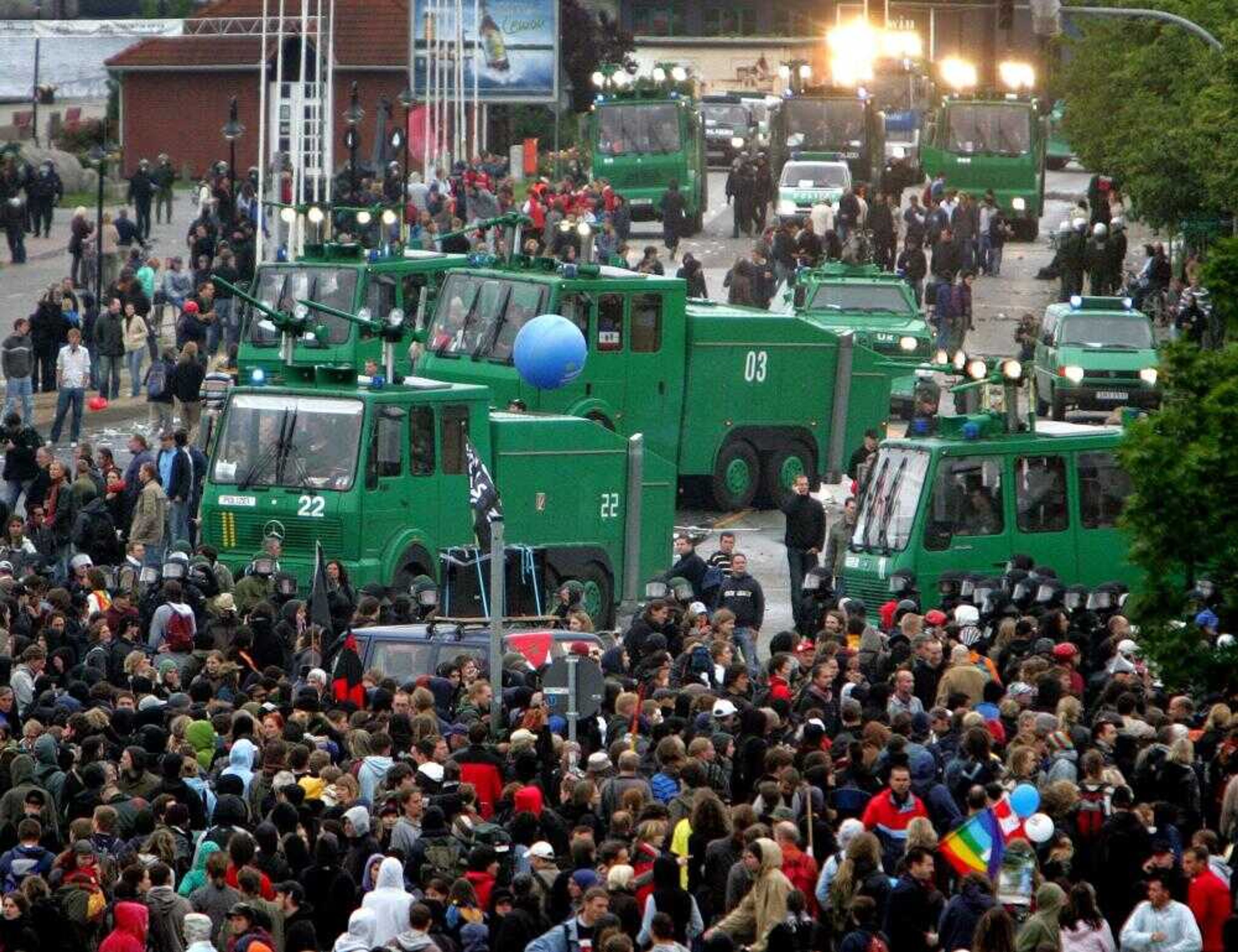G-8 protesters, police clash in violent demonstration
ROSTOCK, Germany -- Protesters with black hoods and bandannas covering their faces showered police with rocks and beer bottles Saturday, before the heavily armored officers drove them back with water cannons and tear gas during a rally against an upcoming Group of Eight summit...
ROSTOCK, Germany -- Protesters with black hoods and bandannas covering their faces showered police with rocks and beer bottles Saturday, before the heavily armored officers drove them back with water cannons and tear gas during a rally against an upcoming Group of Eight summit.
Black smoke from burning cars mingled with the sting of tear gas in the harbor-front area of the northern German town of Rostock, where tens of thousands of people had gathered peacefully at the start of the day. The clashes broke out among hundreds of stone-throwing demonstrators and police on the edges of the crowd as the rally progressed.
Some 146 police were hurt, 25 of them seriously. Police said they made 17 arrests.
It was an unruly start to what is expected to be a week of rallies against the three-day G-8 summit beginning Wednesday in the fenced-off coastal resort of Heiligendamm, 14 miles from Rostock.
German Chancellor Angela Merkel will host the leaders of Britain, France, Japan, Italy, Russia, Canada and the United States for discussions on global warming, aid to Africa and the global economy. The summit, like past ones, is attracting protesters opposed to capitalism, globalization, the war in Iraq and the G-8 itself.
Police have surrounded the summit site with a seven-mile-long fence topped with barbed wire and closed the surrounding waters and airspace, fearing terrorism or disorderly protests like the ones that marred a 2001 summit in Genoa, Italy, where police and protesters clashed for days and one demonstrator was killed. Protests near the fence have been banned.
In Rostock, the officially permitted demonstration began peacefully Saturday with two groups of marchers gathering at the waterfront. Clashes broke out near the end of the scheduled four-hour rally, as some people pried up paving stones and broke them into smaller pieces.
Eventually, five large green police trucks with twin water cannons mounted on top moved in to blast the rioters. A police car was destroyed and several parked cars burned, spreading black smoke over the area. Protesters also torched a large blue recycling bin.
Police spokesman Frank Scheulen estimated the number of violence-minded demonstrators at about 2,000. Police put the size of the demonstration at 25,000, while organizers said it was 80,000.
Werner Raetz, an anti-globalization activist with Attac, one of the organizing groups, distanced himself from the violence: "There is no justification for these attacks."
As for the demonstrations planned over the next few days, Raetz said both sides should try to get the "emotional situation" under control.
There are several camps in the area for protesters, and marches and other events are planned. Some protesters say they intend to try to block roads leading to the summit site.
Peter Mueller, who was among the demonstrators, had tears streaming from bloodshot eyes after the tear gas was released. "As long as the police were in the background it was OK, but as soon as one took a step closer, it went out of control," he said.
He shrugged. "What can you do? So ends the peaceful protest."
The protest was organized by several dozen groups under the motto "another world is possible."
"The world shaped by the dominance of the G-8 is a world of war, hunger, social divisions, environmental destruction and barriers against migrants and refugees," organizers said in leaflets handed out on the streets.
On their Web site, organizers emphasized that they wanted a peaceful protest.
"There is no reason to be afraid to come to the big demonstration in Rostock," they said. "We do not expect major problems with the police."
Anti-globalization protests have plagued similar summits in recent years, especially meetings of the World Trade Organization. In 1999, 50,000 protesters shut down WTO sessions in Seattle as police fired tear gas and rubber bullets. There were some 600 arrests and $3 million in property damage.
At subsequent WTO meetings in Cancun, Mexico, and Hong Kong, smaller protests also disrupted meetings.
Connect with the Southeast Missourian Newsroom:
For corrections to this story or other insights for the editor, click here. To submit a letter to the editor, click here. To learn about the Southeast Missourian’s AI Policy, click here.









